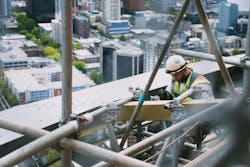Top-down construction: Streamlining the building process | BD+C
Urban projects often face challenges such as limited space, congested environments, and the need for efficient construction timelines, which are all critical to improving urban living. In such scenarios, traditional construction methods can be inefficient and time-consuming. This is where the concept of top-down construction comes into play, offering a solution that is gaining traction once again in the construction industry.
In this blog, we will explore what is top-down construction, why it’s regaining demand, the benefits it offers, and the sequence of this construction method.
Top-down construction: The need for efficient construction in urban areas
Urbanization is accelerating rapidly, with the United Nations projecting that 70% of the global population will live in urban areas by 2050, up from 55% today. This shift has led to an increased demand for vertical construction—high-rise buildings that can accommodate large numbers of people or businesses in a relatively small footprint.
The surge in urbanization also aligns with a rising focus on sustainable design in construction. As cities strive to meet environmental standards, construction methods that minimize impact are in demand. In this context, traditional construction methods often fall short. They can be time-consuming, disruptive to the surrounding environment, and less efficient in space utilization. Urban areas also require more extensive underground facilities, such as subways, parking garages, and utility tunnels.
Top-down construction offers a solution that minimizes surface-level disruptions while accelerating the construction process. This method’s adaptability to the complex demands of urban development positions it as a key strategy in modern construction.
What is top-down construction?
Top-down construction is a method where a building's superstructure (above ground) and substructure (below ground) are constructed simultaneously. This method involves constructing the upper floors of a building first while simultaneously excavating and constructing the lower floors below.
How top-down construction meets the growing demand for urban development
The increasing trend of urbanization has led to a corresponding rise in demand for urban development. Cities are not just growing outward but are also being redeveloped to accommodate higher densities and more complex infrastructures. This has sparked a resurgence in construction methods that can handle the unique challenges posed by urban environments. Here’s how top-down construction helps urban projects:
Reinventing urban spaces
In many cities, older buildings and underutilized spaces are being repurposed to meet new demands. This often involves constructing new structures in close proximity to existing ones, requiring techniques that minimize disruption and maximize efficiency. Top-down construction is particularly well-suited for these scenarios, as it allows new developments to progress without requiring extensive alterations to the surrounding area.
High-rise developments
The push for vertical expansion in cities has led to an increase in high-rise developments, particularly in financial districts, residential areas, and mixed-use developments. These projects demand construction methods that can accommodate the complexity of building upward while maintaining safety and stability. Top-down construction offers a strategic advantage by enabling simultaneous construction of the substructure and superstructure, reducing overall project timelines.
Transport and infrastructure projects
As urban areas grow, the need for improved transportation and infrastructure becomes more pressing. Projects such as underground railways, parking structures, and utility tunnels are increasingly necessary to support the dense populations of modern cities. Top-down construction is often the method of choice for these projects, as it allows for the excavation and construction of underground spaces while minimizing surface disruption.
The advantages of top-down construction for urban projects
If you are curious about why top-down construction is gaining traction in the urban development sector, let’s delve into the benefits it brings to the table. Here are the advantages of this construction method:
- Maximizes urban space: Urban centers often suffer from a scarcity of available land, making it crucial to maximize the use of every square foot. The ability to maintain existing operations above ground while developing below is critical in densely populated areas, where maintaining the flow of daily life is essential.
- Flexibility in design: Modern urban projects often require designs that integrate commercial, residential, and open spaces within a single structure. Top-down construction’s ability to accommodate complex designs makes it ideal for these mixed-use developments, where flexibility and efficiency are paramount.
- Reduced project timelines: By allowing the superstructure to rise while the substructure is being excavated and built, developers can shave months off their project schedules. This is particularly beneficial in cities where construction timelines are often compressed due to high demand for new buildings.
- Complex site constraints: Many urban projects face site constraints such as neighboring buildings, narrow streets, or active underground utilities. Top-down construction provides the flexibility needed to navigate these challenges, as seen in projects like London’s Crossrail, where top-down methods were used to build underground stations beneath active roadways and rail lines.
- Early revenue generation: In some cases, the upper floors of a building can be completed and leased or sold while the lower levels are still under construction. This approach allows developers to begin generating revenue before the entire project is finished, improving the project's overall financial viability.
- Reduced environmental impact: Traditional bottom-up construction methods often require extensive excavation and prolonged construction phases that can disrupt the surrounding environment, including noise, dust, and traffic congestion. Top-down construction minimizes these impacts by containing much of the activity within the building site and reducing the need for large-scale excavation.
- Enhanced safety and stability: Safety is a critical concern in urban construction. Top-down construction provides early structural stability by constructing core walls and columns early in the process, reducing the risk of collapses or other structural issues during the build.
The top-down construction sequence
Understanding the top-down construction sequence is crucial for developers, architects, and engineers looking to optimize their building projects. Let's take a look at the sequence of top-down construction to help you gain an understanding of how to apply this construction method to your projects:
- Construct the retaining wall: Begin by constructing the embedded retaining wall, typically a diaphragm wall, to provide necessary support during excavation. This wall acts as a critical structural element for both the temporary and permanent construction phases.
- Build the perimeter wall and piles: Next, construct the perimeter wall and piles. Steel columns or stanchions are installed in conjunction with the piles, ensuring they are placed accurately to support the load of the superstructure as well as the bracing system.
- First stage of excavation and slab construction: Commence the first stage of excavation, followed by casting the floor slab of the first basement level. This slab must include openings to allow for the lowering of machinery to the levels below and the removal of excavation waste. At this stage, superstructure construction can also begin simultaneously.
- Second stage of excavation and continued slab construction: Proceed with the second stage of excavation, casting the floor slab for the second basement level. This process is repeated for each subsequent basement level, ensuring that each slab provides lateral bracing for the retaining wall.
- Complete excavation and foundation work: Continue the process of excavation and slab construction until the desired basement depth is reached. Once this is achieved, the ground beams and foundation slab will be constructed, completing the basement structure.
- Superstructure construction: Throughout this process, construction of the superstructure continues as planned, progressing vertically as the excavation and basement work advances below. This simultaneous construction approach allows for efficient use of time and resources, leading to the construction speed of the overall project timeline.
Design and construction principles
Top-down construction relies on two major structural elements to ensure stability and safety throughout the process:
- Pre-founded columns: These columns, embedded in the bored piles or diaphragm wall panels, must have sufficient capacity to bear the construction load. They are integral to the bracing system that maintains the structure’s stability during the excavation and construction phases.
- Permanent retaining wall support: Excavation must be carried out with the support of the permanent retaining wall, such as a diaphragm wall with sufficient embedment in firm soil layers. This wall ensures that the basement floor slabs can function effectively as lateral bracing throughout construction.
Considerations for top-down construction
Top-down construction requires careful planning to manage the removal of soil, supply of materials, and ventilation for work conducted below ground:
- Access for removing soil and delivering materials is typically through openings in the ground floor and substructure slabs.
- Adequate ventilation is crucial for ensuring a safe working environment beneath permanent slabs during the substructure construction.
- Given the limited access and space often available in urban settings, excavation and construction methods must be designed to be compatible with the site's specific constraints. This involves ensuring that safe working methods are employed and that all activities are well-coordinated to avoid delays or complications.
Examples of top-down construction in action
One of the best examples of top-down construction is the Burj Khalifa in Dubai, UAE. The Burj Khalifa employed the top-down construction method to manage its extensive underground levels and superstructure. The method allowed for the simultaneous excavation of the deep foundations and the tower's construction above ground.
Another example is the Taipei 101, formerly known as the Taipei World Financial Center, which utilized top-down construction to address the complexities of building a skyscraper with multiple underground levels, including extensive parking and service areas.
Master top-down construction with BD+C
To truly stand out in the construction field, understanding and implementing top-down construction techniques can give you a significant edge. As a professional in the field, you understand the importance of delivering projects that not only meet but exceed client requirements. With BD+C, you can enhance your skills and knowledge about anything building, design, and construction. Subscribe to our newsletter today and get expert advice, market trends, strategies, and more!
FAQs about top-down construction
If you are considering top-down construction for your upcoming project, you may have numerous questions. Here are the frequently asked questions about top-down construction that you may find helpful:
How does top-down construction affect project costs?
While top-down construction can lead to faster project completion, it often requires a higher initial investment in planning and specialized equipment, which can be more expensive upfront. However, these costs can be offset by reducing the overall project timeline, which minimizes labor expenses and site-related disruptions. In urban areas, faster completion can also lead to quicker returns on investment, making it cost-effective in the long run.
Can top-down construction be used for all building types?
Top-down construction is most effective for projects with deep basements and multi-story structures, particularly in urban areas. While it can be adapted to various building types, it is not always the most cost-effective or practical solution for projects without significant underground components or where space constraints are not an issue.
What are the challenges of top-down construction?
Coordinating simultaneous excavation and superstructure construction can be complex, requiring precise management to avoid delays. Additionally, working in confined urban spaces can limit equipment access and complicate logistics, making effective site management essential.

